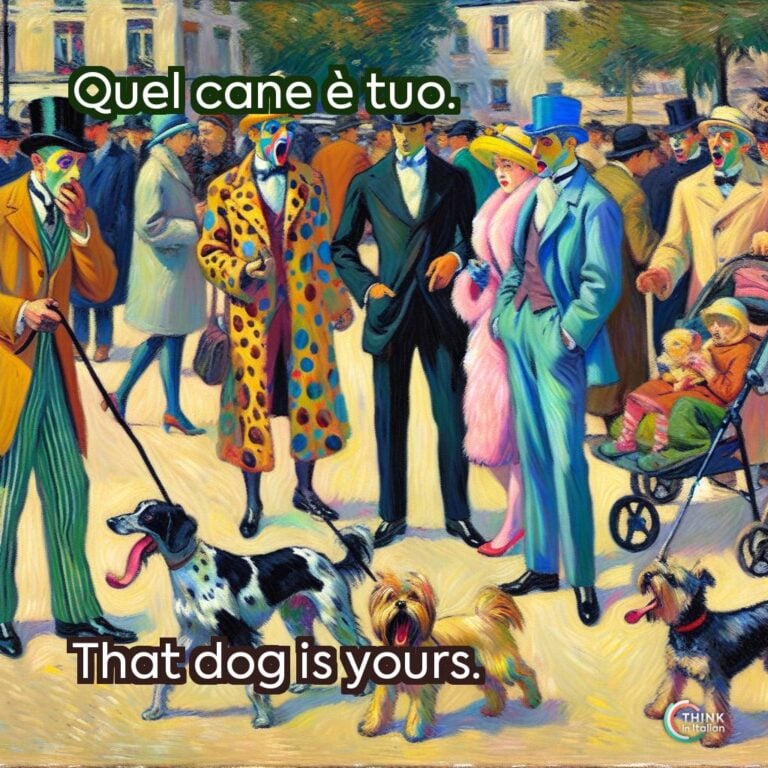Possessive Adjectives
Italian Possessive Adjectives
The term possessive adjectives (aggettivi possessivi) refers to those grammatical structures that indicate possession. English possessive adjectives are “my, your, her, his, its, our, and their”.
- Her jacket is so cool!
- Our friend is not coming.
Italian possessive adjectives behave differently from English ones, and this is why I believe it is important that you understand their main characteristic: unlike English, they agree in gender and number with the item that is owned, and not with the owner.
This is why, as with all adjectives, each Italian possessive adjective has four different forms: masculine singular, feminine singular, masculine plural, and feminine plural.
| Masculine Singular | Feminine Singular | Masculine Plural | Feminine Plural | |
| io | mio | mia | miei | mie |
| tu | tuo | tua | tuoi | tue |
| lui/lei/Lei | suo | sua | suoi | sue |
| noi | nostro | nostra | nostri | nostre |
| voi | vostro | vostra | vostri | vostre |
| loro | loro | loro | loro | loro |
As you can see “loro” never changes.
For instance, cappello (hat) is masculine, so you must use the masculine possessive adjective regardless of the gender of the owner. This distinction is evident in the third person singular only, and might, sometimes, make it hard to understand the gender of the owner unless it is specified.
Questo è il cappello di Laura – è il suo cappello.
This is Laura’s hat – it is her hat.
How to use Italian Possessive Adjectives
As I mentioned before, we use possessive adjectives to talk about possession or ownership. As you might have noticed already, they are almost always used with a definite article (il, la, lo, i, gli, le). This is because they are and, therefore, behave as actual adjectives.
La mia bici è rossa.
My bike is red.
I suoi amici sono inglesi?
Are his/her friends English?
Le vostre pizze sono pronte.
Your pizzas are ready.
The only situations where we do not use an article with a possessive adjective is when we refer to a singular family relations.
Mio fratello è uscito.
My brother went out.
Mi ha chiamato tua mamma.
Your mom called me.
Sua cugina abita a Roma.
His/her cousin lives in Rome.
However, a definite article is used when we refer to plural family relations or any type of family relation where “loro” is the owner.
I loro cugini vivono a Bruxelles.
Their cousins live in Bruxelles.
I miei genitori sono Olandesi.
My parents are from the Netherlands.
Il loro fratello studia Italiano.
Their brother studies Italian.
Possessive Pronouns
Italian Possessive Pronouns
Now that you know what Italian possessive adjectives are, I can introduce you to Italian possessive pronouns, the equivalent in English to “mine, yours, his, hers, its, ours, yours and theirs”.
- This is mine!
- I lost my phone, can you lend me yours?
You probably are familiar with the linguistic term “pronoun“: Pronouns are words that substitute a noun. They are, therefore, used to not repeat a noun. Italian has several different types of pronouns, but here I will focus on possessive pronouns only.
Learn more about personal pronouns, direct pronouns, and indirect pronouns in Italian!
Let me give you good news: If possessive pronouns are easy enough in English, they are even easier in Italian… They are exactly the same as possessive adjectives!
| Masculine Singular | Feminine Singular | Masculine Plural | Feminine Plural | |
| mine | mio | mia | miei | mie |
| yours (for tu) | tuo | tua | tuoi | tue |
| his, hers, its | suo | sua | suoi | sue |
| ours | nostro | nostra | nostri | nostre |
| yours (for voi) | vostro | vostra | vostri | vostre |
| theirs | loro | loro | loro | loro |
How to use Possessive Pronouns
As mentioned before, we use possessive pronouns to replace a noun so that we do not repeat it in a sentence. Unlike possessive adjective that almost always require an article, Italian possessive pronouns are very flexible and can be used in both ways.
Questa borsa è mia, quella è sua. / Questa è la mia, quella è la sua.
This bag is mine, that one is hers.
I libri sono nostri, non vostri. / Questi libri sono i nostri, non i vostri.
The books are ours, they are not yours!
Placement in the Sentence
Although normal Italian adjectives usually follow the noun they modify, Italian possessive adjectives typically precede it. However, just like with other adjectives, Italian allows some flexibility.
In fact, in order to emphasize possession or to clarify to whom the object belongs, especially in a conversation with multiple possible referents, Italians might place the possessive adjective after the noun.
La macchina sua.
The car of his/hers.
Here, the post-nominal adjective emphasizes that the car belongs to him/her, not to someone else mentioned in the conversation.
Also, when a noun is possessed by more than one person and each possessor is indicated separately, Italian requires the possessive adjective for each noun.
La mia borsa e la tua.
My bag and yours.
Il mio cane e il loro.
My dog and theirs.




